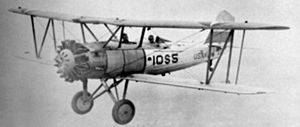Vought O2U Corsair Video - Picture

|
|

Picture - O2U-4 Corsair
Role: Observation
National origin: United States
Manufacturer: Vought
Introduced: 1926
Primary users: United States Navy
United States Marine Corps
United States Coast Guard
Number built: 580
The Vought O2U Corsair was a 1920s biplane scout and observation aircraft. Made by Vought Corporation, the O2U was ordered by the United States Navy (USN) in 1927. Powered by a 400 hp (298 kW) Pratt & Whitney R-1340 Wasp engine, it incorporated a steel-tube fuselage structure and a wood wing structure with fabric covering. Many were seaplanes or amphibians.
Design and development
In 1927, a total of 291 O2Us were produced. The O2U-2, -3 and -4 were ordered in 1928 with minor changes. By 1930 they were being superseded by the O3U which was basically similar to the O2U-4, one of which was fitted with the Grumman float, and were manufactured until 1936. A total of 289 were built. Many of them had cowled engines and some had enclosed cockpits.
Operational history
The 600-690 hp (448-515 kW) Pratt & Whitney R-1690-42 Hornet engine was used to power Corsairs designated SU-1 to SU-4. The change in designation reflected their role as scouts. A total of 289 SU designated aircraft were built for the USN. No less than 141 Corsairs were still serving with the US Navy and Marines when the US entered World War II.
Export versions included the Corsair V-65F, V-66F and V-80Fp for the Argentine Navy, the V-80P for the Peruvian Air Force, and the V-85G for Germany. Japan purchased Corsair variants V-65C and V-92C. Brasil purchased thirty six units V-65B, some hydroplanes V-66B and fifteen V-65F.
In March 1929, Mexico purchased twelve armed aircraft version O2U-2M with the 400 hp (300 kW) Wasp engine to quell a military coup; Mexico then built 31 more units under licence, and called them Corsarios Azcx¡rate O2U-4A. In 1937, Mexico purchased ten V-99M equipped with the Pratt & Whitney R-1340-T1H-1 550 hp Wasp engine, some of them may have been sent to Spain.
China purchased the 42 export versions of O2U-1 from 1929-1933, and 21 export versions of O3U between 1933-1934 and they saw extensive bombing actions. The O2U-1 versions participated in the Central Plains War and in the January 28 Incident against the Japanese targets, while the O3U versions first participated in the Battle of Pingxingguan to support the Chinese ground forces, and later against the Japanese targets in Shanghai.
In 1924 Peru purchased two Vought airplanes which were designated UO-1A. Later, in 1929, 12 O2U-1 were acquired. Used first as trainers, they saw action against APRA rebels in the northern areas of the country, and against Colombian ships and aircraft during the Colombia-Peru War. None were lost due to enemy fire, but several were due to accidents.
Vought would use the Corsair name again for the F4U fighter in 1938, and the A-7 Corsair II attack bomber in 1963.
Variants
O2U-1
two prototypes followed by 130 production aircraft with interchangeable wheel/float landing gear. 450 hp (336 kW) Pratt & Whitney R-1340-88 Wasp engine
O2U-2
increased span and larger rudder
O2U-3
80 built, revised wing rigging, redesigned tail surfaces and Pratt & Whitney R-1340-C engine
O2U-4
42 built, similar to O2U-3 but with equipment changes
O3U-1
87 built, incorporating Grumman amphibious float
O3U-2
29 built, strengthened airframe, Pratt & Whitney R-1690 Hornet engine
O3U-3
76 built, 550 hp (410 kW) Pratt & Whitney R-1340-12 Wasp engine, later redesignated SU-1
O3U-4
65 built, Pratt & Whitney R-1690-42 Hornet engine, later redesignated SU-2 (45 built), and SU-3 (20 built) with low pressure tires
SU-1
28 built
SU-2
53 built
SU-3
20 built
SU-4
41 built, new production version of SU-2
XO3U-5
test aircraft with Pratt & Whitney R-1535 engine
XO3U-6
test aircraft converted from O3U-3 with NACA cowling and enclosed cockpits
O3U-6
32 built, 16 with Pratt & Whitney R-1340-12 Wasp and 16 with Pratt & Whitney R-1340-18 Wasp engines
Vought V-65B
Export version for Brazill - 36
Vought V-65C
Export version for Japan
Vought V-65F
Export version for Argentine Navy
Vought V-66B
Export version for Brazil
Vought V-66F
Export version for Brazil - 15, and Argentine Navy
Vought V-80F
Export version for Argentine Navy
Vought V-80P
Export version for Peruvian Air Force
Vought V-85G
Export version for Germany
Vought V-92C
Export version for Japan
Vought V-99M
Export version for Mexico
TNCA Corsario Azcx¡rate
31 O2U-4A aircraft built under licence in Mexico.
Operators
Argentina
Argentine Navy
Brazil
Brazilian Air Force
China
Chinese Nationalist Air Force
Germany
Luftwaffe
Japan
Imperial Japanese Army Air Force
Mexico
Mexican Air Force
Peru
Peruvian Air Force
United States
United States Navy
United States Marine Corps
United States Coast Guard
Thailand
Royal Thai Air Force had 70 planes operational at the time of the French-Thai War.
Vought O2U Corsair at the Royal Thai Air Force Museum
Specifications (SU-4 Corsair)
Data from "The Complete Encyclopedia of World Aircraft" Editors: Paul Eden & Soph Moeng, (ISBN 0-7607-3432-1), 2002, 1152 pp.

General characteristics
Crew: Two
Length: 27 ft 5.5 in (8.37 m)
Wingspan: 36 ft (10.97 m)
Height: 11 ft 4 in (3.45 m)
Wing area: 337 ft (31.31 m)
Empty weight: 3,312 lb (1,502 kg)
Max takeoff weight: 4,765 lb (2,161 kg)
Powerplant: 1x— Pratt & Whitney R-1690-42 Hornet radial, 600 hp (447 kW)
Performance
Maximum speed: 167 mph at sea level (269 km/h)
Range: 680 miles (1,094 km)
Service ceiling: 18,600 ft (5,670 m)
Armament
3 .30 cal (7.62 mm) Browning machine guns, one forward firing and two on a trainable mount in rear cockpit
Living Warbirds: The best warbirds DVD series.
Source: WikiPedia